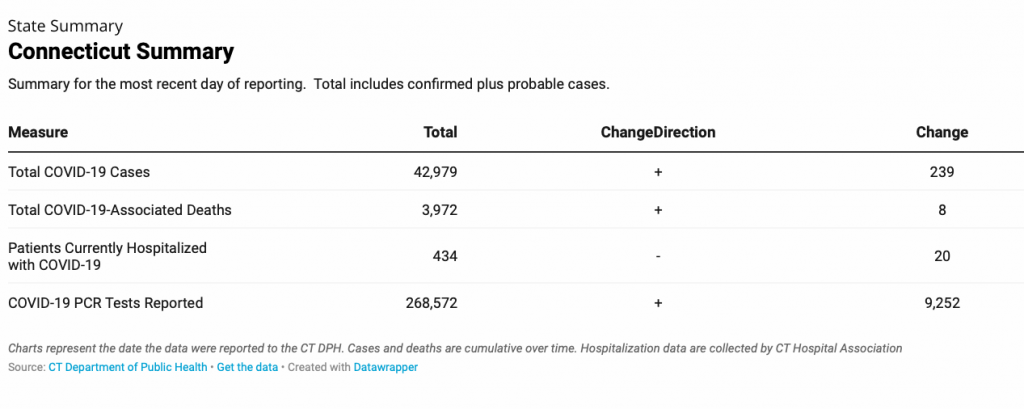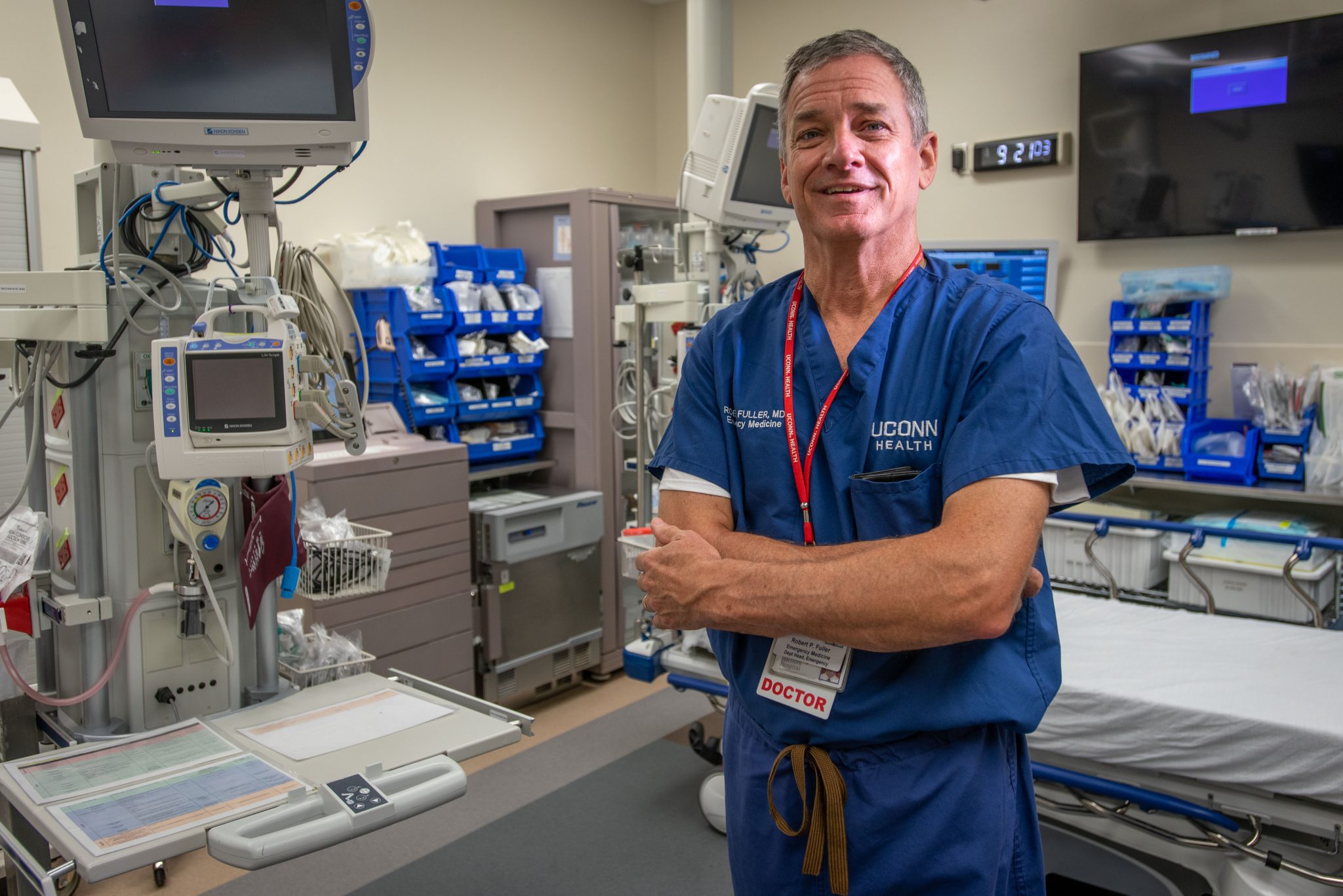New Study Will Attempt to Determine How Widespread COVID-19 is in Connecticut

Audio By Carbonatix

Health care workers at Golden Hill Rehab Pavilion in Milford react with heart hands to a group of Democratic State Senators and State Representatives who visited the facility Friday. They were one of three groups of elected officials traveling across the state visiting fifteen nursing homes to highlight the fact that black and brown people are disproportionately impacted by COVID-19 as workers exposed to the virus and the need for more personal protective equipment. The caravans concluded their tour at Kimberly Hall North in Windsor later in the day. Photo credit: Cloe Poisson, CTMirror.org
Blood samples will be taken randomly from 1,400 people to discover how many have antibodies to the coronavirus.
By Gregory B. Hladky and Isabella Zou, CTMirror.org
Connecticut will be the first state in the nation to conduct a broad survey to determine how prevalent the coronavirus is throughout the state’s population, the governor announced Tuesday.
The research project will take blood samples from 1,400 people chosen randomly from Connecticut’s population to discover how many have antibodies showing they’ve been infected by the virus. Experts believe that many people who are exposed to COVID-19 either don’t have any symptoms or only very mild symptoms that could be mistaken for something else.
The survey will be led by scientists from Yale University in collaboration with Gallup, a nationally known analytics and advisory company, Quest Diagnostics, and the Jackson Laboratory for Genomic Medicine.
“Connecticut has an urgent need to understand the extent of prior infection with COVID-19 in order to guide our efforts to protect the state’s residents, mitigate the harms of the virus, and implement efficient programs in the areas of greatest need,” Gov. Ned Lamont said.
“This innovative new approach puts some of the best scientific minds in the world at work with data that may be able to tell us how deeply this virus has impacted our communities and who may be more susceptible to infection,” said Diedre Gifford, Connecticut’s acting public health commissioner.
Researchers hope to find out how much of the state’s population has been infected by the virus, how many people have experienced mild or no symptoms, and whether different factors, such as age, location, or underlying health conditions, are associated with contracting COVID-19.
Missed testing goal
The Lamont administration’s stated goal for ramping up COVID-19 testing as Connecticut moves to reopen its economy was to test at least 50,000 people a week by the end of May. But reports for the final week of last month indicate fewer than 36,000 tests were actually conducted.
Lamont pointed out Tuesday that testing has increased this week, including the 9,250 tests that were conducted over the past 24 hours. “We have more testing capacity than people getting tested right now,” Lamont said during his regular daily briefing.
The governor also said that the increase of just eight COVID-19-related deaths since Monday “is the lowest fatality rate we’ve had in months.” The Connecticut death toll for the pandemic is now at 3,972.
As of Tuesday, 268,570 coronavirus tests had been conducted during the pandemic in Connecticut, according to the latest state reports. Confirmed and probable COVID-19 cases resulting from those tests totaled 239 new cases.
“These trends are all in the right direction,” Lamont said.
According to data reported Tuesday, there are six more positive COVID-19 cases in West Hartford. The combined total of laboratory-confirmed cases (617) plus probable cases (52) is now 669. There were no additional fatalities reported Tuesday and the total remains 112.

Overall Connecticut deaths – from coronavirus and non-pandemic causes – surged in April and May
There were dramatic increases in the total number of deaths reported in Connecticut in April and May of this year compared to the same period in 2019, according to new data released by the Office of the Chief Medical examiner.
All deaths reported to the medical examiner’s office rose by 137% in April of this year compared to April 2019, jumping from 1,938 deaths for that month last year to 4,602 in April 2020. There were 2,464 deaths in April of this year known to have been related to COVID-19.
In May 2019, there were 1,844 deaths reported, compared to 3,448 fatalities reported to the medical examiner in May 2020, an increase of 87 percent. The number of COVID-19-related deaths in May of this year is believed to be at least 1,453.
Only about two-thirds of all deaths in Connecticut are reported to the medical examiner’s office.
Officials said COVID-19 obviously accounts for most of the reported increase in fatalities but not all of them. Josh Geballe, Lamont’s chief administrative officer, said some of the additional deaths may have been related to COVID-19 but were not attributed to the disease. Experts say other non-coronavirus deaths may have resulted from people who avoided or delayed critical hospital care because they were afraid of going to the hospital during the pandemic.
COVID testing ordered for all nursing home, assisted living center staff
After weeks of controversy over inadequate COVID-19 testing at nursing homes, Lamont on Monday ordered mandatory testing of all staff and residents at nursing homes, assisted living facilities and elderly residential communities.
Experts have said that the lack of broad testing at Connecticut nursing homes and other facilities is a major reason why the infection rates and coronavirus fatalities at those institutions have been so high and so deadly.
Lamont’s new executive order came as state officials reported that nearly 4,000 people in Connecticut have died of coronavirus-related causes. Last month, as the state began wider-scale nursing home testing, resident deaths accounted for nearly 60% of all COVID-19 fatalities in Connecticut.
The governor ordered that, “all staff of these facilities to be tested for COVID-19 weekly for the duration of the public health and civil preparedness emergency.”
Studies have shown that universal testing of both staff and residents of nursing homes is critical to curbing the spread of this virus. State officials have said that limited supplies of testing materials and an initial decision to focus testing on hospitals delayed efforts to check the spread of COVID-19 in nursing homes across the state.
The governor’s action drew praise from the state’s two long-term care associations, LeadingAge Connecticut and the Connecticut Association of Health Care Facilities.
“Launching universal employee and resident COVID-19 testing is an important move to control the further spread of the virus and to hopefully bring us closer to a place of reopening the nursing homes and assisted living communities to visitors,” officials of the associations said in a statement.
New information on non-coronavirus health issues during the pandemic
As efforts to fight COVID-19 continue, data is emerging on how the pandemic is affecting people with other health conditions.
A new study found a 38% reduction in the number of patients reporting to Hartford Hospital with heart attacks since COVID-19 began compared to the previous 14 months.
Dr. Amanda Zaleski, a clinical researcher in the Department of Preventive Cardiology at Hartford Hospital, said Tuesday her research team also found reductions of 25% and 50% in March and April, respectively, compared to those months’ averages over the past four years.
Zaleski said that these results represent a phenomenon that has been seen at other hospitals around the nation, and according to the report, verified in other countries like Spain and Austria.
“It’s very concerning and worrisome,” she said, given that other humanitarian emergencies like 9-11, Hurricane Sandy, and Hurricane Katrina led to an increase in heart attacks.
Combined with the fact that COVID-19 is known to affect the heart, Zaleski said, “It really does beg the question: where have all of these missing heart patients gone?”
While there are no firm answers yet, the report details “many possible explanations.” Those include the possibility that some people susceptible to heart attacks may have died from COVID-19. But the study’s data strongly suggests that most of these “missing” patients are waiting at home, putting off seeking care for as long as possible, Zaleski said.
Patients who do become hospitalized for heart conditions waited an average of three days after experiencing symptoms.
“Patients are starting to come back in, however, they’re looking much worse because of how long they’ve delayed their care,” Zaleski said.
In response, Zaleski emphasized the importance of being aware of the symptoms of a heart attack, which include crushing pain, tightness, and squeezing in the neck and the back, nausea, and fatigue. She urged people to seek care as quickly as possible if they or their family members begin to experience these symptoms.
Dr. Alan Solinsky, an ophthalmologist at the Hartford Hospital Eye Surgery Center, also described a drastic reduction in patients seeking eye care during COVID-19—although for more tangible reasons. The 80% decrease in patient volume they’ve seen is largely due to the elderly makeup of their patient base, and the American Academy of Ophthalmology’s order for practices to stop seeing routine patients to maximally protect their safety.
However, important surgeries have also seen a decline, he said. Cataract surgeries have decreased by 500,000 cases in the last three months, in comparison with the two to three million performed per year in the U.S.
He emphasized that avoiding an appropriate cataract surgery leads to dangerous driving and lower quality of life, and is unnecessary during COVID-19 – he stressed facilities’ extensive COVID-19 safety procedures, ranging from the check-in process to strict precautions taken by medical staff.
Unemployment benefits and a family’s risk of infection
The governor’s latest executive order also addressed what would happen to a worker’s unemployment benefits if he or she is afraid to return to work because of a COVID-19 infection danger to the employee’s family.
Lamont’s order allows state labor officials, when determining eligibility for unemployment benefits, to consider if a return to work would pose “an unreasonable risk to the health of a member of that worker’s household.” Lamont has said he believes workers should still be eligible for jobless benefits if their risk of infection from a return to their employment was too high.
Pandemic has resulted in cleaner air for Connecticut – for now
The drastic reduction in highway traffic and industrial production as a result of pandemic-related restrictions and cutbacks has had at least one major, if temporary, benefit: dramatically improved air quality in Connecticut.
State environmental officials reported Tuesday that “monitored levels for many air pollutants dropped significantly from mid-March to mid-April.”
“Connecticut suffers from some of the worst air quality in the country, especially along congested transportation corridors,” officials of the state Department of Energy and Environmental Protection said in their report.
Stay-at-home orders have cut highway traffic significantly, however, dramatically slashed air travel and reduced business and commercial activity across Connecticut and much of the region to the west and south that sends pollution into this state.
Between March 14 and April 26, DEEP monitors found nitrogen dioxide levels dropped by 13 to 37 percent compared to the previous three-year period. Carbon monoxide levels were down 7 to 21 percent, and sulfur dioxide levels dropped by as much as 57 percent.
“The tragic disruption of coronavirus has given us a glimpse of what our future environment could look like if we invest in more clean energy and clean transportation solutions,” DEEP Commissioner Katie Dykes said.
SNAP recipients can now order food online
Recipients of the Supplemental Nutrition Assistance Program (SNAP) will now be able to purchase food online from grocery stores participating in the program, state officials said.
People enrolled in SNAP, which provides food assistance for people below certain income levels, will be able to use their electronic benefit transfer (EBT) card to buy eligible food items on line for curbside pickup or delivery, according to officials of the Department of Social Services.
Reprinted with permission of The Connecticut Mirror.
Like what you see here? Click here to subscribe to We-Ha’s newsletter so you’ll always be in the know about what’s happening in West Hartford! Click the blue button below to become a supporter of We-Ha.com and our efforts to continue producing quality journalism.



